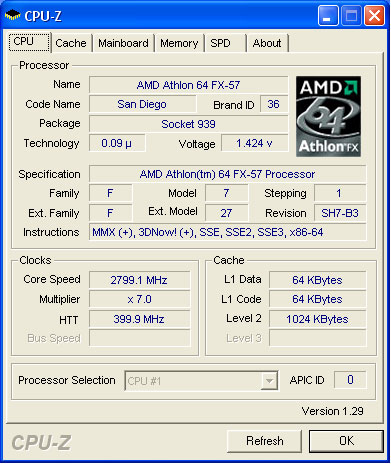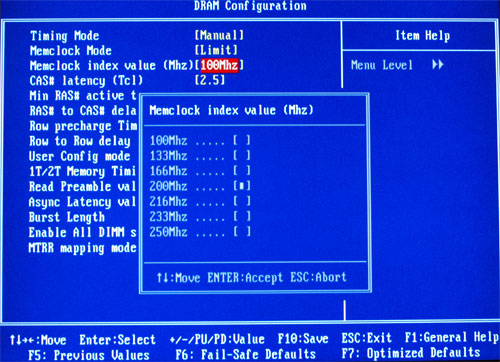ULi M1695 PCIe/AGP for Athlon 64 – Part 2 with SLI
by Wesley Fink on August 5, 2005 10:00 AM EST- Posted in
- Motherboards
Overclocking : ULi M1695/M1567 Reference 2
ULi tells us that they have improved overclocking on the Reference 2. Our OC tests confirm that claim.| ULi M1695/M1567 Reference 2 | |
| Clock Speed Overclocking | |
| Processor: | Athlon 64 FX57 (2.8GHz, 1MB Cache) Athlon 64 4000+ (2.4GHz, 1MB Cache) |
| CPU Voltage: | 1.55V (default 1.40V) |
| Cooling: | Thermaltake Silent Boost K8 Heat sink/Fan |
| Power Supply: | OCZ Power Stream 520W |
| Memory: | OCZ PC3200 EL Platinum Rev. 2 (Samsung TCCD Memory Chips) |
| Hard Drive: | Seagate 120GB 7200RPM SATA 8MB Cache |
| Maximum OC: (Standard Ratio) |
242x12 (4x HT, 2.5-3-3-10) 2904MHz (+21%) |
| Maximum FSB: (Lower Ratio) |
400 x 7 (2800MHz) (3x HT) (2 DIMMs in DC mode) (+100% Bus Overclock) |
In the first OC testing with the Reference 2, we really did no better with our 4000+ than our last efforts, which reached 300 in FIRST LOOK: ULi M1695 PCIe/AGP Socket 939 for Athlon 64. ULi suggested that we test with the FX57 for the 400 Clock Frequency, and this indeed worked for an incredible 400x7 clock speed.

The second possibility is the memory controller, with the FX57 having a much better Rev. E+. The memory controller for Rev.E is much improved, according to AMD, and the FX57 is the latest in the Rev. E memory controller family.
Regardless of the reasons why FX57 worked at 400, we are still left with the severe overclocking limitation of no voltages for memory in the ULi Reference 2 BIOS. We had to toss our normal overclock procedures out the window to bring you a better idea of the overclocking capabilities of this board. Without memory voltage, the only way that this can be tested is by lowering memory ratios to those that can run at default voltage. In this case, that would be a 100 setting on memory, so the 400 clock setting would yield a 200 base or DDR400 at the fixed memory voltage. ULi needs to correct this and provide memory voltage adjustments to 3.2V or more in production boards.
Due to the improved performance of the FX57 in overclocking, we plan to use the FX57 or another Rev. E Athlon 64, in future overclocking tests.











46 Comments
View All Comments
AMDScooter - Friday, August 5, 2005 - link
^^^ Same. My OC'd S754/Clawhammer plays all current games fine. Seeing as none of the titles I play currently can take advantage of SMP now anyway I am really in no rush to migrate. That combined with the fact my X800 XTPE on the AGP bus still has plenty of bandwidth to spare. Also, the lack of NV drivers for all games to be able to take advantage of 2 video cards makes me lean more for the ATI chipset soloution anyway. My2c..MarkB - Friday, August 5, 2005 - link
How about using the OCZ memory volatage booster card for the overclocking tests.. would be crazy to see performance at 400 FSB and high clocked ram.SpaceRanger - Friday, August 5, 2005 - link
I thought the OCZ Memory thing was just a voltage stabilizer, not a booster. Maybe I am getting the 2 modules confused..Lonyo - Friday, August 5, 2005 - link
Nah, I'm fauirly sure it adds voltage adjustments up to either 3.2 or 3.5v."The OCZ DDR Booster with patent-pending PowerClean technology supplies “cleaner” power to the installed memory modules and allows increasing their voltage above the rated one"
http://www.xbitlabs.com/articles/memory/display/oc...">http://www.xbitlabs.com/articles/memory/display/oc...
"in the extreme right position, the memory receives a voltage of 3.9v."
It would be a little unfair since no other tests have been run with the booster, but it would be nice to get a sneak peek at possible performance of very high speed RAM with AMD64 and a high FSB. Some nice OCZ VX in there with the booster and 3.5v or so would be something worth seeing.
nserra - Friday, August 5, 2005 - link
Wesley Fink there are some questions unanswered, yet.The performance in IDE and SATA is impressive.
Does it have SATA NCQ?
You should also ask about this riser card, because the final version must have 3 PCIe 16X slots, with 2 working has 8X, I doubt that the riser card is a good working solution, because if I put the board in a case how can I connect the monitor cables or even insert the cards on the riser ?
Also how does it have 2 PCIe x4 (or x2) if it has only 20 PCIe lanes, or does this mean only one will work in 4X mode and 2 in 2X mode?
Also ask about when we should expect mobo’s with those chipset start selling?
Example: http://www.asrock.com/product/product_939Dual-SATA...">http://www.asrock.com/product/product_939Dual-SATA...
Wesley Fink - Friday, August 5, 2005 - link
Yes, ULi tells me this south bridge board does support NCQ - as do the coming M1573 and M1575 south bridges.I do not know the final solution on the riser card. This is a Reference Board for qualification. Manufacturers will decide what they wish to implement. As I stated in the review I do agree the riser is not a likely production feature.
As you can see in the BIOS picture on page 4, the options are 1 x4 or 2 x2 - total 4 lanes added to the 16 equals 20. ATI actually has 22 lanes in their chipset and use the extra 2 lanes for communication between north/south bridge.
joex444 - Friday, August 5, 2005 - link
Notice that in the BIOS screenshot it says:1x16 1x4
1x16 2x2
2x8 1x4
So, you have a choice of running 1 x4 card or two x2 cards.
Can you run x4 cards in an x4 slot at x2 speed? Heck, where are the x4 cards anyways, can't say I've actually seen an x4 slot on a board before, either.
jpkomm - Friday, August 5, 2005 - link
I asked ASrock's US sales division the same thing. They said the "939Dual-SATA2" motherboard will not be available in the US market. Of course, I'm not too sure if that is unshakable or not. They may or many not release it here; however, they may do it but just in a different flavor. Your guess is as good as mine. I love the reviews pumping up this chipset, but I have yet to find anything solid as to US releases. Guess I will just sit patiently and wait.lsman - Friday, August 5, 2005 - link
OCworkbench.com review this board as these jumpers are for"FUTURE_CPU_PORT"...Socket M2..
so may be the board to look for..
http://www.ocworkbench.com/2005/asrock/reviews/939...">http://www.ocworkbench.com/2005/asrock/reviews/939...
Xenoterranos - Friday, August 5, 2005 - link
Anyone know where/when to get one of these. This is exactly what I need, as I and probably thousands of you have an AGP card and don't want to spring for PCIe yet.